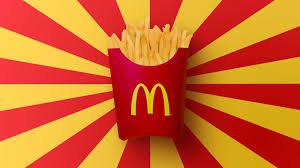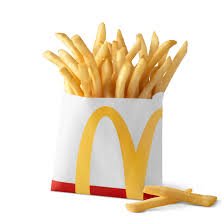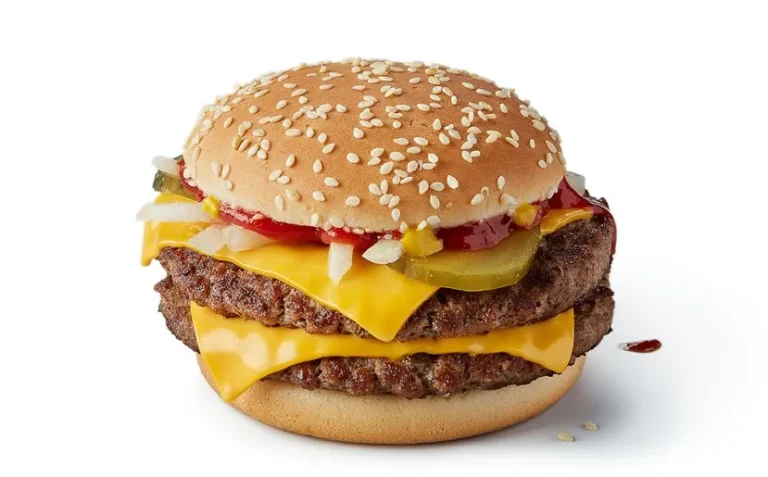Are You Curious To Know About McDonald’s fries Calories? Their crispy texture and perfectly salted flavor have made them a staple side dish for countless meals around the globe. However, as delicious as they are, it’s essential to be aware of McDonald’s fries’ calories if you’re aiming to maintain a balanced diet.
We’ll dive into the calorie content of different serving sizes, explore their nutritional profile, and discuss how you can enjoy these iconic fries without compromising your health goals. Whether you’re grabbing a quick snack or adding them to your meal, understanding the calorie count will help you make informed choices, allowing you to savor every bite while keeping your diet in check. Join us as we uncover the tasty details behind McDonald’s fries and how you can indulge wisely!
Table of Contents
The Origins of McDonald’s Fries

McDonald’s began serving its iconic fries back in 1940. Richard and Maurice McDonald started with a simple San Bernardino, California, menu. These original fries were cooked in beef fat, which gave them a unique flavour. This secret recipe contributed to their early popularity. In the early 1980s, McDonald’s switched to vegetable oil for frying.
This change aimed to reduce trans fat content and appeal to health-conscious consumers. Despite this shift, the fries have retained their beloved taste. Today, they remain a favourite side item worldwide. Their origin story reflects McDonald’s ability to adapt while maintaining core flavours. This blend of tradition and innovation continues to delight fans globally.
Nutritional Profile of McDonald’s Fries
| Attribute | Details |
| Caloric Content of Different Serving Sizes | Small: 230 caloriesMedium: 340 caloriesLarge: 510 calories |
| Macronutrients in McDonald’s Fries | Medium: 44g carbohydratesMedium: 16g total fat |
| Micronutrients in McDonald’s Fries | Medium: 560mg potassiumSmall amounts of iron and calcium |
| Fat Composition | Medium: 3g saturated fat0g trans fat |
| Carbohydrates and Fiber | Medium: 44g carbohydrates3g dietary fiber |
| Protein Content | Medium: 4g protein |
Macronutrients in McDonald’s Fries
| Nutritional Attribute | Amount | Daily Value Percentage |
| Total Fat | 16 grams | 25% of daily recommended intake (2,000-calorie diet) |
| Saturated Fat | 3 grams | 15% of daily recommended value |
| Trans Fat | 0 grams | – |
| Total Carbohydrates | 44 grams | – |
| Dietary Fiber | 3 grams | – |
| Protein | 4 grams | – |
Micronutrients in McDonald’s Fries
| Nutritional Attribute | Amount | Daily Value Percentage |
| Potassium | 560 mg | – |
| Iron | – | 2% of daily recommended intake |
| Calcium | – | 2% of daily recommended intake |
| Vitamin C | Trace amount | – |
| Sodium | 190 mg | – |
Health Considerations

When enjoying McDonald’s fries, it’s crucial to consider their nutritional impact. McDonald’s fries calories can quickly add up, especially with larger servings. A medium frie packs around 340 calories, mostly from fats and carbs. This can be significant if you’re watching your weight or overall health. The fries contain about 3 grams of saturated fat, which could impact heart health if consumed regularly.
Sodium is another concern; a serving of around 230 mg can affect blood pressure. Therefore, frequent consumption might lead to health issues over time. However, you can still enjoy these iconic fries without compromising your health goals by practising portion control and balancing meals with healthier options.
Portion Control and Balanced Meals
Managing portion sizes is crucial for enjoying McDonald’s fries responsibly. Try a small or medium serving instead of always opting for a large. This simple change can help you manage your calorie intake effectively. Complement your fries with healthier sides, like apple slices or a side salad, to create a balanced meal.
Adding these nutritious options increases the fibre and essential vitamins. If you find it hard to resist more significant portions, consider sharing with a friend. Sharing allows you to indulge while reducing your overall calorie consumption. Also, be mindful of what you drink; opt for water or unsweetened beverages. This choice can help you avoid extra calories from sugary drinks. By making these conscious decisions, you can enjoy your fries and maintain a balanced diet.
The Future of McDonald’s Fries

As consumer preferences evolve, McDonald’s is adapting its menu. Healthier versions of classic items are being tested, including air-fried options. Reduced sodium fries are also being explored in select locations. The goal is to maintain the iconic taste while offering healthier choices. Additionally, McDonald’s is committed to sustainability. The company is focusing on sourcing sustainable potatoes and reducing greenhouse gas emissions.
Minimizing waste is also a priority, leading to potential changes in fry production. These efforts align with consumer demand for healthier, eco-friendly options. Innovations in McDonald’s fries are on the horizon. Fans can look forward to enjoying their favourite fries while supporting a more sustainable and health-conscious future.
Sustainability Efforts
McDonald’s is dedicated to sustainable practices in its operations. They’ve committed to sourcing sustainable potatoes and ensuring environmentally friendly farming methods. Additionally, the company aims to reduce its greenhouse gas emissions significantly. This goal includes more efficient energy use and better waste management practices. Minimizing waste is another priority, with efforts to improve packaging and recycling.
These initiatives align with global sustainability trends and consumer preferences. McDonald’s also works with suppliers to ensure ethical practices throughout the supply chain. These changes reflect a broader commitment to social responsibility. As a result, fans can enjoy their fries while supporting a greener planet. Transitioning to sustainable practices is a crucial part of McDonald’s future.
Comparing McDonald’s Fries to Other Fast-Food Chains
- Burger King Fries:
Burger King’s fries are thicker and have a different seasoning blend, offering a distinct taste compared to McDonald’s.
- Wendy’s Fries:
Wendy’s fries are known for their natural-cut, skin-on appearance and sea salt seasoning, providing a more rustic flavor profile.
- Five Guys Fries:
Cooked in peanut oil, Five Guys fries offer a unique flavor and are often praised for their generous portions and fresh-cut quality.
- KFC Fries:
KFC’s seasoned fries feature a distinctive blend of spices that complements their fried chicken, making them quite different from McDonald’s.
- Shake Shack Fries:
Shake Shack serves crinkle-cut fries, which are crispy on the outside and soft on the inside, offering a unique texture experience.
Cultural Significance of McDonald’s Fries

Few foods have captured the global imagination, like McDonald’s fries. They’re not just a side dish; they’re a cultural icon. Over the decades, these fries have transcended borders, becoming a universal comfort food. They symbolize convenience, indulgence, and childhood memories. McDonald’s fries are a common thread, from busy city streets to remote rural areas.
Movies, TV shows, and social media often feature them, emphasizing their cultural impact. People share fry-related memes, stories, and photos, creating a shared experience. They evoke nostalgia, recalling simpler times and family outings. Internationally, they’ve adapted to local tastes while retaining their essence.
Events like “Free Fry Day” have turned these crispy treats into moments of joy. This widespread appeal underscores their significance in modern pop culture, uniting fans across generations and geographies.
Enjoying McDonald’s Fries in Moderation

Enjoying McDonald’s fries in moderation is all about balance. Start by choosing a smaller size, like the small or medium fries. This helps control calorie intake and keeps portions reasonable. Pair your fries with healthier options like a side salad or apple slices. This adds nutrients and variety to your meal.
Also, consider sharing a larger serving with a friend to cut calories while indulging. Being mindful of your overall diet is essential. Limit how often you include fries in your meals to avoid overconsumption. Drinking water instead of sugary drinks can also help maintain a balanced diet. Finally, savour each bite to enjoy the taste and texture fully. Moderation allows you to relish McDonald’s fries without compromising your health.
Frequently Asked Questions
What is the calorie count of a medium serving of McDonald’s fries?
A medium serving of McDonald’s fries contains approximately 340 calories. This serving size is popular for those seeking a balance between indulgence and portion control.
Are McDonald’s fries cooked in trans-fat-free oil?
Yes, McDonald’s switched to a vegetable oil blend free of trans fats in the early 1980s. This change catered to health-conscious consumers while retaining the fries’ beloved flavor.
What are some healthier alternatives to McDonald’s fries?
Healthier alternatives at McDonald’s include apple slices and side salads. These options provide lower calorie counts and complement your meal without compromising nutritional goals.
How does McDonald’s ensure sustainability in its fry production?
McDonald’s is committed to sourcing sustainable potatoes and reducing greenhouse gas emissions. The company also focuses on minimizing waste through improved packaging and recycling practices.
Conclusion
Understanding McDonald’s Fries’s Calories can help you enjoy them wisely. While they are delicious, it’s essential to be mindful of portion sizes. Opt for smaller servings to keep your calorie intake in check. Balance your meal with healthier options, such as a side salad or apple slices. Remember, moderation is vital to maintaining a balanced diet.
As McDonald’s continues to innovate, healthier and more sustainable options may become available. Stay informed and make choices that align with your health goals. By doing so, you can savour these iconic fries without compromising your well-being. Enjoy McDonald’s fries as an occasional treat, ensuring they fit into a well-rounded diet.





